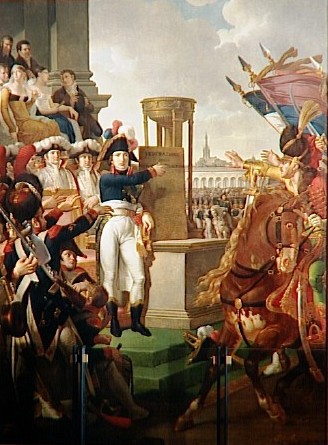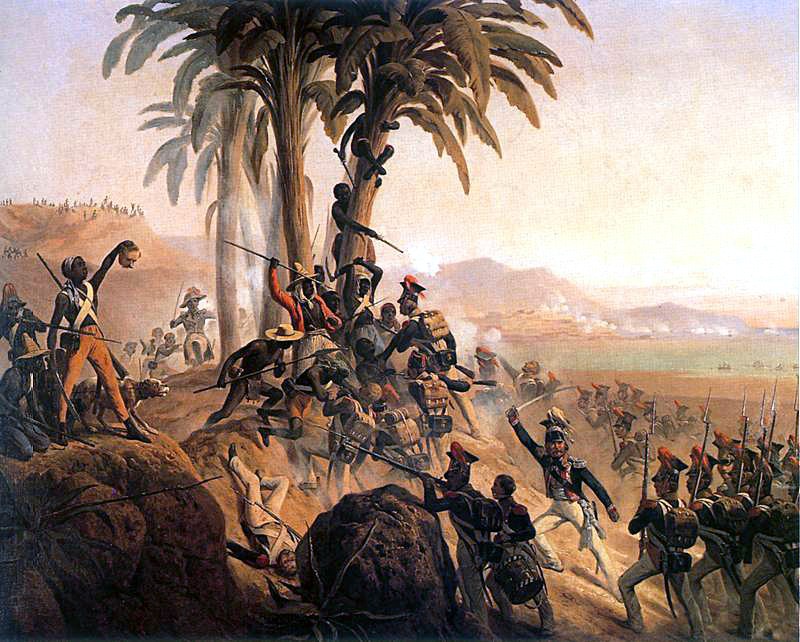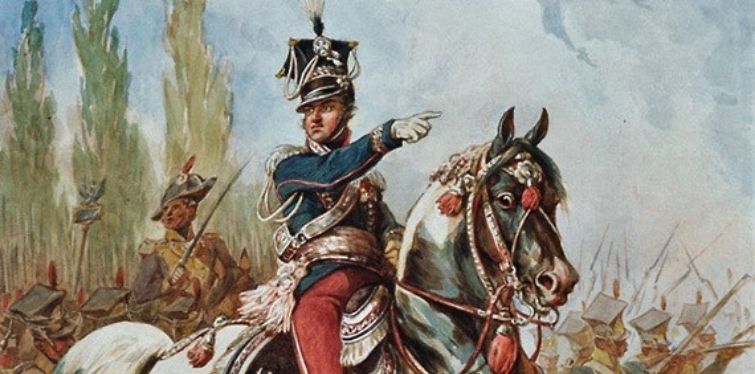This is the second part of a blog series looking into the experience of Poland during the Revolutionary and Napoleonic Wars. The first instalment looked at the Partitions of Poland in the late 18th century, which saw the Polish-Lithuanian Commonwealth expunged from the map of Europe. This post will cover the Polish patriots and soldiers who formed Polish Legions, fighting under the French Republican armies and seeking to resurrect their homeland.
Poland had enjoyed good relations with France in the 18th century. King Louis XV had married the daughter of Stanislaw Leszczyński, who had briefly been King of Poland during the Great Northern War. France championed Leszczyński’s claim on the throne during the War of the Polish Succession in 1733-35, eventually losing out to the Russian candidate Augustus III of Saxony. Perhaps most importantly, France was the only major continental European power which had not taken a bite out of Poland. France and Poland were therefore natural allies.
During the latter stages of the Kościuszko Uprising, when all seemed to be lost, General Jan Henryk Dąbrowski developed an audacious plan to unite all remaining units in the Polish army, with King Stanislaw Augustus at its head, and march west to join up with French armies fighting the Prussians on the Rhine. Upon hearing of the King’s reluctance to leave Warsaw, he even considered abducting him. In the end, the plan was abandoned and Dąbrowski was among the officers compelled to surrender to the Russian army.
Jan Henryk Dąbrowski
Even as Poland was being erased from the map, Dąbrowski returned to his idea of fighting for the restoration of Polish independence with French support. In early 1795 the Revolutionary armies had conquered the Netherlands and established the Batavian Republic, overthrowing the old order. Many Polish patriots were in exile in Paris and were in negotiations about supplying Polish troops to the Revolutionary cause. Having rejected Russian and Prussian efforts to recruit him, Dąbrowski met with Generals Jourdan and Bernadotte who enthusiastically supported his project and gave him letters of recommendation to Paris.
Arriving in the French capital at the end of September 1796, Dąbrowski presented his proposal to the Directory. These legions would be comprised of exiled generals and officers who had refused to serve in the armies of partitioning powers, with rank and file Polish prisoners of war captured from the Austrian army. They would coordinate their actions with Polish soldiers who were in Ottoman exile and made plans to cross the border into Habsburg territory and encourage an uprising in Galicia (the Austrian share of the partition). The project would serve French interests by re-establishing an ally in central Europe and destabilising Austria and Russia, and serve Polish interests by creating a well-trained military force enabling her to win back her independence.
Although Dąbrowski’s project was appealing to the French authorities, the French Constitution did not allow the army to take foreign troops into its pay. Minister of War Louis Petiet circumvented this obstacle by writing to General Napoleon Bonaparte, commander of the Army of Italy, who had won a series of incredible victories over the Austrians in 1796. By establishing the provisional government of the Italian territories under French occupation, the Poles could serve in the new Italian army. Bonaparte already had with him a talented Polish aide-de-camp by the name of Jozef Sułkowski, who had earlier fought against the Targowica Confederation. Through Sułkowski, he had already been aware of these plans and was sympathetic towards them. The pieces were falling into place, and Dąbrowski hurried to Italy.
Jozef Sułkowski
He arrived in Milan on 2 December and presented his proposals to Bonaparte a few days later. By 9 January 1797, an agreement was made to establish Polish legions in the service of Lombardy. Dąbrowski got to work forming his legions, sending word to Paris for the release of Polish prisoners captured from Austria. Only a few days later, however, Bonaparte had won a brilliant victory at Rivoli and captured 25,000 Austrian prisoners in a lighting campaign. Impatient as ever, Dąbrowski issued a proclamation from Milan to his brethren:
Poles! Hope shall rally us! France triumphs, it fights for the cause of nations; we try to weaken its enemies; it grants us asylum, we await a better destiny for our land. Let us array ourselves under their flags, they are those of honour and victory. Polish legions are forming in Italy, on this land formerly the sanctuary of liberty; already officers and soldiers, companions of your labours and your courage, are with me, the battalions are already organizing themselves! Come, companions, throw away the arms which you have been forced to carry! Let us fight for the common cause of nations, for freedom under the valiant Bonaparte, conqueror of Italy.
By 9 February 1797, 1,127 Poles had enlisted in the legion, which was organised into a battalion of grenadiers and another of chasseurs. They wore Polish uniforms, Italian epaulettes, and a French cockade. By this point, the Austrian army at Mantua had surrendered after a four month siege. At the beginning of March, the Polish Legion was ordered go to Mantua, where its ranks were augmented by prisoners and deserters. These Polish troops were subsequently involved in pacifying the region and quelling minor disturbances.
By the end of March, Bonaparte had marched into Austria and taken Klagenfurt. Dąbrowski presented a plan to take his Polish corps, now 5,000 strong, through Croatia and Hungary into Galicia. Bonaparte ordered the Poles to concentrate at Palmanova near Trieste, which encouraged the Polish general’s hopes. However, with Vienna at risk of enemy occupation, the Austrians made at preliminary peace with Napoleon at Leoben and ceded much of northern Italy. These arrangements dashed Dąbrowski’s plan. Not for the first time, the Poles would learn that their interests were subordinate to those of France and of Napoleon.
In spite of the setback, Dąbrowski dutifully led his legions to march on Treviso as part of Napoleon’s efforts to subjugate the Venetian Republic and transfer it to Austria as compensation for the conquered northern Italian territories. Venice surrendered not long after the Poles arrived at Treviso on 6 May. The Poles were then sent to the garrisons at Mantua and Bologna.
Meanwhile, on 19 May, General Bonaparte proclaimed the establishment of the Cisalpine Republic, with its capital in Milan. This enabled the formal organisation of the Polish troops into two legions, each of three battalions. The Polish exiles in Paris entertained the possibility of re-establishing the Sejm in Milan to have a constitutional basis for their deliberations and their diplomatic representations. Disagreements among the group about the propriety of such a move meant the idea was not carried forward. Many exiles lost heart and decided they could do no more to further their cause. Some returned to Poland and entered the service of the partitioning powers.

General Bonaparte proclaims the Cisalpine Republic
Among the men who remained committed to the cause, the poet and diplomat Jozef Wybicki left Paris to join Dąbrowski in Milan. In July, Dąbrowski was ordered by Bonaparte to take 1,000 men to pacify disturbances in Reggio Emilia. While in Reggio, Wybicki wrote a poem to boost the morale of the Poles serving in Italy. He set the text to a lively mazurka inspired by folk motifs under the title ‘Song of the Polish Legions in Italy.’
The first verse reminded the soldiers that though Poland could no longer be seen on the map of Europe, the nation remained alive with them:
Kiedy my żyjemy
Co nam obca moc wydarła,
Szablą odbijemy.
So long as we still live.
What the foreign power has seized from us,
We shall recapture with a sabre.
The catchy refrain referenced Dąbrowski’s ambition to march his legions from Italy to Poland:
Do Polski z ziemi włoski
Za twoim przewodem
Złączym się z narodem.
To Poland from the Italian land.
Under your command
We shall rejoin the nation.
The rest of the song referenced Bonaparte’s example as a liberating hero, as well as a series of major historical events in Poland’s national struggle. The song was well-received almost immediately. Dąbrowski wrote to Wybicki, “The soldiers seem to like your song more every day. We are humming it often too, with all the due respect to the author”. Over the course of the nineteenth century it would become one of the most popular songs among Polish patriots dreaming of resurrecting their homeland. It came to be known as ‘Dąbrowski’s mazurka’ and more than a century later in 1926 was adopted as Poland’s national anthem, using an amended text from 1806. The most notable change was to replace umarła (died) in the first line with zginęła (perished), suggesting a more violent form of death.
In September, while Napoleon was seeking to put pressure on the Austrians during negotiations for a final peace at Campo Formio, the Polish legions were once again ordered to Venice. Their ranks had by now swelled to over 7,000 men. Included among them were senior officers such as General Karol Kniaziewicz, a veteran of the Kościuszko Uprising who had escaped captivity and was given command of the 1st Legion. The Poles entertained hopes that their grand project might be revived, but on 17 October the Treaty of Campo Formio was signed between France and Austria, and the War of the First Coalition was over.
Karol Kniaziewicz
Instead, Dąbrowski’s men would join the Cisalpine Army’s operations against the Papal States. Advancing towards Rimini in early December 1797, Dąbrowski took the fortress of San Leo after a three day siege. Alongside General Teodoro Lecchi’s Italians, Dąbrowski stationed his men on the frontier between the Cisalpine Republic and the Papal territories. Political disturbances in Rome at the end of December, which resulted in the assassination of General Duphot, led to an invasion of the Papal states. In February 1798, an army under Louis-Alexandre Berthier, Napoleon’s chief of staff, marched on Rome and occupied the Eternal City. The Pope was imprisoned and a new government established as the Roman Republic.
In May Dąbrowski and his 1st Legion arrived in Rome. While there, the Polish general was presented with an Ottoman flag captured by King Jan Sobieski during his relief of Vienna in 1683 and deposited at the Church of Santa Maria di Loreto. The crescent standard was adopted as a battle standard for the Polish 1st Legion for the remainder of the wars. As for Sobieski’s sword, which was also deposited at the church, Dąbrowski sent it as a gift to Kościuszko, who arrived in France from the United States in June 1798. Later that year Kościuszko met with General Bonaparte to discuss the organisation of the legions. The Polish revolutionary hero was not impressed, and later said of Napoleon, “He only thinks of himself, not about nationalist ideas, and so he could not care less about any dreams of independence [of Poland]. He is a despot, whose sole ambition is to satisfy his personal ambition. He will create nothing of any permanence, of that I am sure.”
In the summer of 1798, most of the French troops defending the Roman Republic had left for the Egyptian Campaign, leaving the Poles to keep order in Rome. The Polish troops were poorly equipped and received little financial assistance from the French authorities in Rome. Dąbrowski was obliged to go to Milan to demand the money due to the legions. Meanwhile, now falling under the command of General Macdonald, the Poles were involved in crushing several brutal rebellions around Rome, costing the 1st Legion sixty dead and fifty wounded.
By now a Second Coalition had been assembled against the French Republic. A 40,000 strong Neapolitan Army under the command of General Karl Mack invaded the Roman Republic. The French Army of Rome had been reduced to 16,000 effective men, under the overall command of Jean-Etienne Championnet. This talented officer embarked on a strategic retreat to gather his forces, allowing the Neapolitan Army to take Rome. On 4 December 1798, General Macdonald’s corps of 10,000 men deployed on high ground near Civita Castellana was attacked by Mack’s whole army. All of the Neapolitan attacks were repulsed, and General Kniaziewicz’s 1st Legion managed to rout the enemy left despite being surprised by a flank attack. This battle shifted the momentum in the campaign and Championnet successfully retook Rome a month after abandoning it. Poles were able to strengthen their ranks with Polish prisoners and deserters forcibly recruited into the Neapolitan army by the Austrians. In December Dąbrowski rejoined the 1st Legion and obtained permission to raise a 300 man regiment of Polish cavalry mounted on captured horses.

Etienne Macdonald
The Poles then accompanied Championnet as he assumed offensive operations against the Kingdom of Naples. Dąbrowski and Kniaziewicz distinguished themselves at the crossing of the Garigliano, which enabled the French cross into Neapolitan territory. On 22 January the French took the city Naples and proclaimed the Parthenopean Republic. The French Republic now controlled most of the Italian peninsula via a handful of sister republics. Following the victorious campaign, Championnet did not forget to honour his brave Polish subordinates. Dąbrowski was given command of a division, while Kniaziewicz was dispatched to Paris with a group of Polish officers carrying the flags captured from the Neapolitans, where he was welcomed with a magnificent ceremony.
Having nullified the threat from southern Italy, the Republican armies were now faced with a renewed Austrian threat from the north. The three battalions of the 2nd Legion, as part of Scherer’s Army of Italy, played an active role in the fighting along the Adige River. At the Battle of Magnano on 5 April, the 2nd Legion lost 1,000 men killed, wounded, and captured. General Franciszek Rymkiewicz, commander of the 1st Battalion, won battlefield promotion to Brigadier General but died from his wounds a few days later. As he drew his final breaths, he lamented, “Why did destiny not permit me to die on the soil of my country?”
The fortunes of the Republican armies did not improve much over the course of the year. Ill-equipped and outnumbered, the Army of Italy, now under the command of General Moreau, was no match for the Austro-Russian army under the command of Field Marshal Suvorov, nemesis of the Poles. On 29 April, Suvorov took Milan and abolished the Cisalpine Republic. Dąbrowski was ordered to gather his division and march to Florence and Rome, relieving the denuded French garrisons and helping to put down local insurrections encouraged by the renewed hostilities. In May, Dąbrowski’s divison managed to take control of the Apennine passes, keeping communications open between Moreau’s Army of Italy and Macdonald’s Army of Naples.
Dąbrowski subsequently joined Macdonald as he marched north in an attempt to link up with Moreau. During the Battle of the Trebbia (17-20 June), Dąbrowski’s 5th Division found itself in the thick of the action. On the second day of the battle the Poles had been caught out in a surprise attack by Prince Bagration’s vanguard, during which Dąbrowski was wounded and had to fight his way out of enemy cavalry. The following day an outflanking manoeuvre carried out by the Poles was intercepted and defeated by a Russian column led by Suvorov himself. The Legion lost 1,000 killed and wounded as well as 500 prisoners during the battle, but some prisoners escaped and rejoined the ranks, which were also replenished by captured Poles in Russian and Austrian service.

Battle of the Trebbia
Meanwhile, the 2nd Polish Legion, which had been assigned to the garrison at Mantua, had been besieged by a coalition army since the beginning of April. After a lengthy siege, the fortress capitulated on 28 July. As part of the conditions, Austrian deserters were to be returned to their regiments and their lives spared. The Austrian officers interpreted this condition to encompass the Poles who had deserted from the Austrian army to join the Legion. While the Legion was marching out of the city under the surrender terms, they were attacked by the Austrian army. The 2nd Legion’s commander General Wielhorski was taken captive along with senior officers. Only 150 members of the Legion managed to accompany their Republican brethren back to France.
The 2nd Legion was all but destroyed. Meanwhile, the 1st Legion narrowly avoided playing a significant part in the defeat at Novi on 15 August, where the Army of Italy commanded by Generals Joubert and Moreau suffered a heavy at the hands of Suvorov, losing a third of its strength in the process. Joubert was killed in the process. Dąbrowski and the 1st Legion were tasked with protecting the retreat of the defeated army. Thankfully for French Revolutionary armies, the momentum in Italy shifted when Suvorov was ordered over the Alps in an attempt to relieve General Rimsky-Korsakov’s army in Zurich. The French Revolutionary armies in Italy were left to face General Michael von Melas’s Austrians, and saw more success. On 24 October 1799, at the Second Battle of Novi, which was fought near the site of the first battle, General Laurent Gouvion de St-Cyr’s column overcame a stoutly defended Austrian position. Dąbrowski’s Poles played a crucial part in this victory, on one occasion successfully charging at energy cavalry with bayonets. The 1st Legion spent the remainder of the year engaging in a series of small battles and skirmishes with the Austrians.
By the end of 1799, the Polish Legion was severely lacking in food, clothing, and all other supplies. Dąbrowski’s efforts to request further provisions were denied, as the French soldiers were in equally bad shape. Eventually, the Polish commander was persuaded to travel to Paris and make representations to First Consul Bonaparte, who had taken power in November. The First Consul approved a plan to reorganise the legions. The whole Polish corps would gather in Marseille and be taken into the pay of the French Army. It would take the name of the 1st Polish Legion, organised into seven battalions of infantry and one of artillery. Meanwhile, the Polish cavalry regiment would join the Danube Legion in the Army of the Rhine, which had been raised by General Kniaziewicz. Polish officers were sent to depots across the country to recruit Polish prisoners of war captured from the Austrian and Russian armies.
In spite of these reorganisation plans, the three battalions which had previously made up the 1st Legion continued to be engaged against the Austrians. General Championnet had died in early 1800 and was replaced as commander of the Army of Italy by General André Massena. The Poles formed part of a corps under General Louis-Gabriel Suchet. In late March the Poles were destined to go to Marseille to carry out the reorganisation plan, but the Austrians siege of Genoa obliged them to return to action. Throughout May the Poles were involved in a series of skirmishes. When Massena surrendered Genoa on 4 June after a heroic resistance, Suchet’s corps withdrew to Nice and re-opened communications with France. Meanwhile, Napoleon led his famous campaign which culminated in victory over the Austrians at Marengo on 14 June, restoring French dominance in northern Italy.
The Poles were down to 800 men in Italy, but the success at Marengo once again inspired Dąbrowski to present a plan for the liberation of Poland. He suggested that a Polish Corps of 20-30,000 men could be formed on the left wing of the Army of the Rhine, which would march to Galicia via Bohemia and Moravia. He argued that it was in the interests of Prussia and Russia for the Austrians to be weakened, and even suggested that they might be persuaded to give up their shares of the partitions by being given territory in Germany and Turkey as compensation. Dąbrowski obtained permission to bring the Polish troops to Milan and to complete the reorganisation there. The Legion’s strength was back up to 5,000 men, its numbers swelled by the return of the men and officers who had been taken prisoner at Mantua.
The 1st Legion, under Dąbrowski’s overall command, spent the winter of 1800-01 laying siege to the Austrian garrison at Peschiera on the banks of Lake Garda. Meanwhile, General Kniaziewicz’s 6,000-strong Danube Legion had accompanied Moreau’s Army of the Rhine in to Bavaria. At the Battle of Hohenlinden they spearheaded an attack by General Decaen on the southern flank, cutting off Austrian General Riesch’s column and enabling Moreau to win a decisive victory. Hohenlinden was a major factor in encouraging the Austrians to make peace with the Treaty of Lunéville, signed on 9 February 1801.
As at Campo Formio, the provisions at Lunéville said nothing about the fate of Poland. The legionnaires were disgruntled and many left the ranks after losing faith in Napoleon. Those that remained were reorganised into three demi-brigades (the 1er, 2e and 3e Demi-Brigades Étrangère). In 1802, the first two demi-brigades, made up mostly of the Poles who fought in Italy, were sent to Saint-Domingue (Haiti) in an attempt to put down the Haitian Revolution. Napoleon did not wish to risk Frenchmen in a theatre known for its high attrition and brutal fighting, and therefore sent the disgruntled Poles among other foreign contingents. Of the 5,280 men who sailed across the Atlantic, two years later there remained a few hundred survivors. 150 Poles even changed sides and joined the Haitian rebels, recognising that they were the liberators.

Polish Legions in Saint-Domingue
It was an ignoble end for the brave men who had fought with Dąbrowski in Italy. The Poles had won the respect of their French comrades-in-arms, and always hoped that one day they would have the opportunity to accomplish the glorious task of liberating their homeland. Time and time again, their hopes were subordinated to the demands of their French superiors. Dąbrowski was not given the opportunity to march from Italy to Poland, but his example inspired Polish patriots at home that they might one day restore their liberty alongside their French comrades-in-arms.





Share and get 15% off!
Simply share this product on one of the following social networks and you will unlock 15% off!